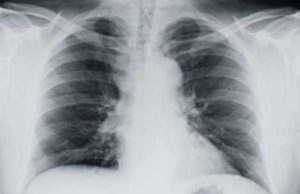
Mesothelioma Explained:
Malignant mesothelioma is a rare cancer that evolves from the mutation of cells in the mesothelium—protective lining of several internal organs.
Malignant mesothelioma is typically caused by prolonged exposure to asbestos fibers. When disturbed, asbestos propels cancerous filaments into the air. These filaments, when inhaled over a period of time, stick to the mesothelium and eat away at the protective lining. The destruction of the mesothelium yields several symptoms; however, these symptoms are slow-developing and will not be observed for decades following the initial exposure to asbestos.
The majority of mesothelioma tumors develop in the internal wall of the abdomen or the lining of the lungs. Common symptoms attached to the disease include: shortness of breath, pleura effusion (a build-up of fluid between the abdomen and lungs), severe weight loss, persistent coughing, chest pains, difficulty swallowing and night sweats.
Malignant mesothelioma is nearly impossible to detect in its early stages. The complexities associated with mesothelioma diagnosis stems from the cancer’s dormant symptoms. A mesothelioma sufferer may not notice symptoms until 50 years after he/she initially was exposed to asbestos.
Similar to other cancers, malignant mesothelioma is categorized by stage. When the disease advances it will shift into the next stage (mesothelioma is categorized from stage I to stage IV). As the disease evolves it becomes exceedingly deadly. The insidious nature of malignant mesothelioma is coupled with the cancer’s inconspicuousness symptoms to create an extremely dangerous medical condition.
In most mesothelioma cases, a mesothelioma patient will not know he/she has the disease until the cancer has metastases throughout the body. When proliferation occurs (stage IV), the disease becomes inoperable. If the cancer, by chance, is detected before proliferation, curable treatment options, such as surgery, may be suggested to extract the malignant tumors. In most scenarios; however, detection will not be fulfilled at an early stage, leaving the patient with only palliative mesothelioma treatment options.
What To Do If You Think You Have Mesothelioma Cancer:
If you have a prolonged history of asbestos exposure you must immediately seek medical help. If you have worked with asbestos-containing materials in your past, you must understand that perpetual exposure to the carcinogenic element may perpetuate cancerous diseases, such as mesothelioma.
Prolonged exposure to asbestos necessitates a physical examination or consultation with a medical professional. Even if you are not experiencing common mesothelioma symptoms you must make this appointment. Preliminary medical help is crucial; a doctor will conduct numerous imaging tests to inspect your tissues, cells and vital organs. If the doctor notices any irregularities, further tests will be done to secure a diagnosis. Hopefully at this point, it’s not too late. Remember, the disease is slow-forming and utterly inconspicuous; however, when it evolves and proliferates it becomes inoperable. Mesothelioma in stage III or IV yields a life expectancy of roughly 2 years.
Imaging Tests Used to Detect Mesothelioma Cancer:
The First Test: Chest Scan
The diagnosis of respiratory conditions (including malignant mesothelioma) necessitates the utilization of chest X-rays scans. Chest x-rays are taken on prospective mesothelioma patients to reveal irregular thickening of the pleura (thin layer of tissue that cushions and protects the lungs).
Chest x-rays are medal imaging techniques that are used to diagnose injuries to bones and irregularities in soft tissue, including the lungs. A chest x-ray therefore, may be used to diagnose mesothelioma cancer, as well as lung cancer and pneumonia.
Chest x-rays are utilized by medical professionals to reveal unusual thickening of the pleura and whether fluids have congregated in the pleural space. A chest x-ray will also search for calcium deposits on the pleura.
In general, a chest x-rays builds the foundation for mesothelioma diagnosis. The preliminary imaging technique will observe the presence of pleural plaques and lung scarring to build a mesothelioma diagnosis case.
Although a chest x-ray is always applied to build a mesothelioma diagnosis, the imaging technique has several flaws, including non-specificity. A chest x-ray cannot delve deep into the tissues to reveal irregularities that would likely be noticed by more advanced imaging platforms.
A chest x-ray is a common mesothelioma diagnostic tool. Applied first, the chest x-ray is effective in locating a mesothelioma tumor. Once an infected region is located, a medical professional may postulate as to whether or not the cancer has proliferated.
Chest x-rays are applied in conjunction with blood tests and CT scans to detect the presence of malignant mesothelioma. However, the downside of these mesothelioma diagnostic tests is that they are incapable of affirming a diagnosis during the disease’s earliest stages of development. If a chest x-ray reveals any irregularities, your doctor will have you undergo a CT scan.
CT Scans as a Mesothelioma Test:
Medical imaging is crucial to evaluate the formation of malignant mesothelioma. Imaging tests like CT scans and MRI’s enable medical professionals to diagnose mesothelioma cancer by observing the level of proliferation and the cellular makeup of the body’s protective tissues.
Computed tomography is an efficient imaging modality utilized for diagnosing and staging mesothelioma cancer. That being said, a CT scan is limited in accurately diagnosing malignant mesothelioma, especially when compared to alternative diagnostic tests, such as MRI and PET scans.
CT scans are the primary imaging modality applied to observe precursors of mesothelioma cancers. Findings may suggest mesothelioma cancers include nodular pleural thickening, unilateral pleural effusion and/or interlobar fissure thickening. Asymmetrical growth promotes tumoral encasement of the lungs and tumoral encasement of the lungs. When this is observed from a CT scan, the cells transform into rindlike shapes. CT scans, thus, look for said irregularities to build a case; diagnosing mesothelioma is a puzzle, and a CT scan is the foundation to solve the conundrum.
In addition to shifts in cellular shape and size, CT scans utilized for mesothelioma diagnosis will find calcified pleural plaques in roughly 20% of patients with the cancer.
Malignant mesothelioma is acutely aggressive; invasion of the chest cavity and diaphragm is often observed. Involvement in the chest cavity will manifest as a termination of extra-pleural fat planes, invasion of intercostal muscles, displacement of ribs and destruction of the bones. However, fluctuations in the interface between the chest wall and the tumor are not a reliable predictor of chest wall invasions.
As mentioned above, CT scans are used as precautionary steps in diagnosing mesothelioma. A CT scan is only applied after a chest x-ray is taken. The CT scan is ordered before MRI’s or PET scans are applied.
How is a CT Scan Performed?
During a CT scan a patient will lie on a padded bed/table and the CT scanning machine will rotate around their body. The process is painless; however, the patient must remain still. Moreover, the patient may be given an injection of dye to bolster picture clarity and visibility. A CT scan as a mesothelioma diagnostic tool takes between 30 minutes and hour to complete.
CT scans for mesothelioma help determine the size, location and extent mesothelioma tumors. The CT scan will also reveal irregularities such as: pleural effusions, pleural thickening and irregular cellular structures. Moreover, CT scans help indicate the proliferation of mesothelioma cancer beyond the lymph nodes or chest wall.
A CT scan is a radiographic technique that utilizes a computer to combine multiple x-ray images into 2 dimensional cross-sectional photographs. The CT machine will rotate around the patient’s body 180 degrees, sending out thin x-ray beams to various points in the body. The machine uses crystals—located on opposite sides of the beam to secure and record the absorption rates of the thickness levels of the patient’s bone and tissue. If a CT scan further reveals irregularities a medical professional may opt to have an MRI performed on a prospective mesothelioma patient.
MRI’s:
An MRI (magnetic resonance imaging device) is an imaging device that utilizes magnets to generate images of the human body’s interior structures. An MRI scan is tremendously beneficial for observing soft tissues. This ability allows a medical professional to pinpoint any irregularities in tissue strength and volume, thus promoting an inkling regarding the presence of mesothelioma cancer.
An MRI is able to view bodily tissues because the images are generated through an advanced scanner that utilizes magnets to form a magnetic field. The magnets excite the protons located within the water molecules of the body. These protons align within the magnetic field and are then pushed by a complimentary field to disrupt alignment. When the protons realign, they generate radiofrequency to produce the image. The multiple agents are then utilized to increase the signal so that the image can be excessively detailed.
MRI as a Mesothelioma Test
Similar to other imaging tests for mesothelioma diagnosis, an MRI scan is an image-based examination that is far superior to x-rays. The supremacy of the MRI scan is found in its ability to observe the internal tissue of the targeted region. Images generated from an MRI may be similar to those offered by a CT scan; however, the MRI bolsters efficacy by revealing the contrast of soft tissue. The MRI, therefore, is able to reveal the smallest variations between similar structures in soft tissue alignments, as well as in between different parts of other internal structures.
An MRI is effective for the staging and planning of mesothelioma treatment options. A medical professional utilizes an MRI to determine how malignant mesothelioma has progressed and proliferated to surrounding tissues so that surgery may be properly planned.
A primary difference between an MRI and CT scan is expressed in the long-terms risks of the mesothelioma diagnostic tests. A CT scan utilizes ionizing radiation techniques that may damage tissues; in contrast, an MRI utilizes magnetism, which does pose any documented risk factors.
Mesothelioma Tests: Biopsies
Following the administration of the aforementioned mesothelioma tests, a medical professional may conduct a biopsy to affirm the presence of mesothelioma cancer. To reach a conclusive diagnosis, the professional must confirm that the patient’s cells are cancerous. Arguably the most effective means to secure is achieved through a biopsy. This test is considered vital to affirm a mesothelioma diagnosis.
In simple terms, a biopsy is the removal of tissues or fluid samples from the patient’s body. The extracted samples are subsequently observed under a microscope to reveal the presence of mesothelioma tumors. A biopsy may also review, by analyzing the interaction of cells, the proliferation and type of cancer present in the prospective mesothelioma patient.
A medical professional may choose between several biopsy procedures to secure a mesothelioma diagnosis. Different biopsies are applied to evaluate the presence of different mesothelioma cancers. For instance, for a peritoneal mesothelioma diagnosis, a fine-needle aspiration biopsy is administered, while prospective pleural mesothelioma patients undergo a thoracoscopic biopsy.
Types of Biopsies:
Although a thoracoscopic biopsy often yields the most accurate results for mesothelioma diagnosis, this particular biopsy is not always appropriate because of fluctuating tumor locations. Additional biopsies used to diagnose mesothelioma include:
Fine Needle Aspiration Biopsy: A safe and relatively quick biopsy, which uses a long hollow needle to extract up to 10,000 sample cells from the prospective mesothelioma patient. This biopsy is often preferred because it reaches remote areas of the lungs and chest cavity without the need for anesthesia. The fine needle aspiration biopsy inspects for peritoneal or pleural effusion and boasts an efficacy rate of 84 percent.
Thoracotomy: A surgical biopsy used to inspect the heart, aorta, trachea, diaphragm and lungs.
Endoscopic Biopsy: The most common biopsy for mesothelioma diagnosis. Endoscopic biopsies use a fiber optic endoscope to inspect the patient’s pleura cavity and protective tissues. Forceps are attached to the tool to extract tissues from the tumor.
Thoracentesis: A biopsy that extracts fluids from the pleura and lungs through the use of a hollow needle. The extracted fluids are analyzed to determine the presence of mesothelioma.
Excisional Biopsies: An excisional biopsy that extracts an entire tumor or infected organ. This biopsy eliminates the need for subsequent surgeries to extract the tumor if further diagnostic tests reveal malignancy.
Core Biopsies: In a core biopsy only a small percentage of irregular tissue is removed from the mesothelioma patient. This type of biopsy is common when the patient’s infected tissue is easy to reach and collect. Unfortunately, the bulk of mesothelioma tumors are not located in accessible areas.





























